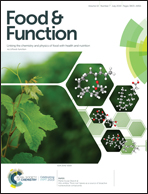Anchusa azurea Mill. (Boraginaceae) aerial parts methanol extract interfering with cytoskeleton organization induces programmed cancer cells death†
Abstract
The present study aimed to determine the chemical composition, antioxidant effects and antitumor properties of a methanol extract of Anchusa azurea Mill. (Boraginaceae) aerial parts against four tumour cell lines (MCF-7, MDA-MB-231, RKO, and R2C). The antioxidant effects were assessed by using β-carotene bleaching, 2,2′-azinobis(3-ethylbenzothiazoline-6-sulfonic acid) (ABTS), 2,2-diphenyl-1-picrylhydrazyl (DPPH), and ferric reducing ability power (FRAP) tests. HPLC analyses revealed chlorogenic acid, catechin, caffeic acid, and astragalin as the most abundant compounds. Interesting results were obtained in the β-carotene bleaching test with IC50 values of 7.6 and 27.5 μg mL−1 after 30 and 60 min of incubation, respectively. Furthermore, the A. azurea extract protects 3T3-L1 mouse cells from oxidative stress induced by menadione and exhibits good antitumor activity, with very low toxicity. Our data indicate that the antitumor properties are due to the ability to induce programmed cancer cell death through caspase 3/7 and 9 activation and interference with the cytoskeleton dynamics.



 Please wait while we load your content...
Please wait while we load your content...